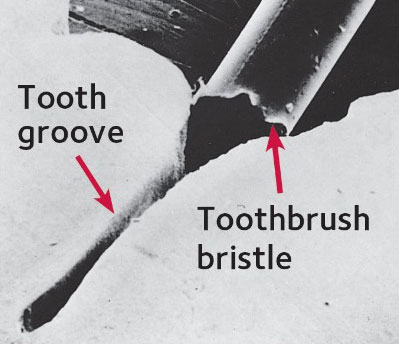Our teeth are covered with a sticky film of bacteria, called plaque (sounds like PLAK). When we eat or drink anything that contains sugar-such as cookies, candy, soda, juice, or sports drinks-bacteria turn the sugar into acids that can attack tooth enamel. Over time, these attacks may cause tooth decay, or cavities. The good news is that there is a way to protect teeth and prevent decay: dental sealants.
Sealants
Why are sealants needed?
Tooth decay often begins on the chewing surfaces of the back teeth. These surfaces have pits and grooves that trap plaque, bacteria, and bits of food. The pits and grooves are hard to keep clean, because toothbrush bristles cannot reach into them.
That is how decay starts in the pits and grooves and cavities form. To keep decay from starting here, the dentist may recommend dental sealants.

Even a toothbrush bristle is too big to reach inside a groove in the tooth (magnified).
How are sealants applied?
Sealants are easy to apply. It takes only a few minutes to seal each tooth. First, the tooth is cleaned and the chewing surfaces are prepared to help the sealant stick to the tooth. Then the sealant is painted onto the chewing surface where it bonds to the tooth and hardens. A special light may be used to help the sealant harden. Sealants are generally clear or white and cannot be seen when you smile or talk.

Tooth surface before a sealant is applied

Tooth surface protected by a sealant
How long do sealants last?
Sealants usually last several years before they need to be replaced. Over time, sealants can become loose or worn. Then they may not protect the teeth as well. Chewing on ice or hard foods can also break down sealants. During regular dental visits, your dentist will check your sealants and reapply them if needed.
How else can I protect teeth from decay?
Sealants protect only the chewing surfaces of teeth. To prevent cavities, follow these Healthy Smile Tips:
- Brush your teeth twice a day with a fluoride toothpaste.
- Clean between your teeth once a day.
- Eat a healthy diet and limit snacks.
- Visit your dentist regularly.
These good habits stop decay from forming in between the teeth-spots that sealants cannot cover.
Who should get sealants?
Sealants are most often placed in children and teenagers, since tooth decay can start soon after teeth come in. But adults can sometimes benefit from sealants too, because you never outgrow the risk for developing cavities.
A sealant can be placed on a tooth that does not have a cavity in its pits and grooves. If a tooth is stained or has mild decay, your dentist may suggest you get a sealant, or another option may be necessary. If a tooth has more advanced decay, it will need a filling.
Prevention is always better than treatment. Sealants are very useful in preventing tooth decay on the back teeth and can save patients money over time. Your dentist can make sealants part of your plan for a healthy mouth.
Sealant photos courtesy of Dr. Adam A. Francois.

